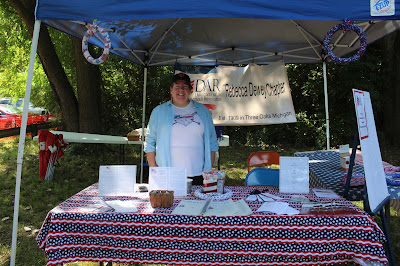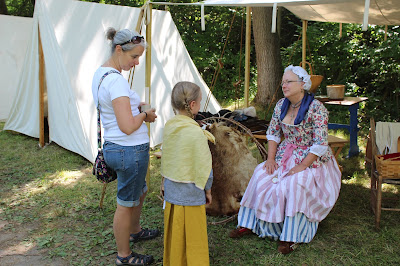We already miss you very much. Yesterday, we packed up all of our belongings and left your beautiful riverside town. On our way out, we made sure to wave goodbye to all of the restaurants on Main Street we frequented, the coin laundromat where we washed our clothes, Martin's supermarket where we consistently had to go to buy more bread (we eat a LOT of sandwiches), the Niles District Library, and of course, the site. It was a sad but cathartic goodbye, and in the words of field school student Shailee, "leaving Niles feels almost wrong."
We have each gained something special with our experience at Fort St. Joseph and in Niles. Of course, it all culminated in the final weekend with our annual Open House, wherein we had the chance to meet with nearly everyone who has supported the project, as well as several Niles inhabitants who we had not previously met, but knew all about us. It was exhausting, anxiety-inducing, and intense, but all of us would agree that the Open House was something we will never forget and would love to do ten times over. We were prepared and pleased to answer all of your hard questions. We had considered every complicated scenario, and made it work. We made our throats raw with how much we wanted to tell you about what we've done. We were a proud, energetic, and happy crew. But now, we must pass it on to next year's field crew.
Don't get us wrong, we are definitely going to milk our hard work until next summer. You will likely see news of us in classrooms and other public spaces, on posters and flyers, on Facebook, Instagram, Snapchat, and Twitter, and hopefully at next year's Open House talking about what we found and what it means. All of our excited bragging about what we found wouldn't mean a thing if we didn't explain the "how" and "why", right? That's what makes it all so exciting. Our end goal is to make accurate connections with the past and then tell the whole world.
I would like to personally thank certain community members and organization for their efforts to support our work this summer and in previous years.
Mary Ellen, thank you for your amazing excavation techniques and ability to mobilize a plan to get the work done, whether it be at the site, for a party, or for a tour, you are always on top of things and we are eternally grateful for your love and support.
Neil and Lynn, thank you for giving your time and energy towards implementing the dewatering system, building the ghost structure for the Open House, and all other logistical work that you have accomplished this summer.
Stephanie, thank you so much for giving us a roof over our heads and a working AC system! After a long day at the field, we are grateful to have such a comfortable and safe place to rest our heads and share our meals.
Christina and Mollie, thank you for your efforts in planning, implementing, and supervising the various public events that have happened in Niles. There is only so much work that the field crew can accomplish, but it is simply astounding and inspiring how you two succeeded this summer.
To the Kiwanis Club, DAR, Chamber of Commerce, Friends of the Niles District Library, South Bend History Museum, the Pokagon Band of Potawatomi, WSJM, WNIL, WestSouthwest, Niles Daily Star, Michiana Life Article, South Bend Tribune, The Buchanan Paper, WWMT, the Herald Pelladium, and all others who have provided food, entertainment, knowledge, wisdom, advertisement, and funds to the project this summer and in the past. We thank you with all of our hearts.
As the days turn, we slowly begin the final week with this season's field crew, as it is the last week of this summer semester. The students and staff will round out all their hard work by digitizing all of their notes, maps, and other documents, so they are readily accessible via computer. During this time, we will be reminiscing on our time in Niles. As always, we will be doing so as a group. I will not forget this family that I've been invited into these past six weeks, nor would I allow myself to do so.
Personally, I have experienced many community-living situations and gained many lifelong friends; however, there is nothing quite like this project. For me, the choice to apply for the site photographer and social media coordinator positions was career-driven, and I liked the idea of working at such a world-renowned place. Right now, thinking back to my application and acceptance for the position, I'm happy that my experience was much different than expected. Each day was begun with a smile and an energy that I've never had before. This job made me excited to get ready for work every day and begin with a "what's next?"
Thank you all for giving me that energy, and making everything worth it.
I must bid you adieu, as there is still so much for me to do. Until next time,
Hannah Rucinski














































